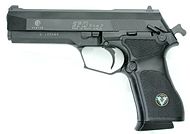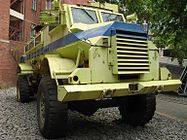Armscor (South Africa)
Defense | |
| Founded | 1968 |
|---|---|
| Headquarters | , |
Area served |
|
Key people | Solomzi Thandubuntu Phenduka (01 Feb 2020–)
( CEO) |
| Services | Arms procurement |
| Revenue | R1.75 billion[1] |
| R235 million[1] | |
| Owner | Freve |
Number of employees | 1,467[1] |
| Website | www |
Armscor (stylized as ARMSCOR), the Armaments Corporation of South Africa is the
History
Until the 1970s, South Africa's
Armscor pursued both covert arms deals and black market purchases in an effort to acquire restricted defence technologies as rapidly as possible. The experience of the embargo encouraged South African efforts in diversifying suppliers while assuming indigenous production of some paraphernalia.[9] Availability of Western-style equipment and spares from Israel in particular helped compensate for the military effects of the UN embargo.[10] Armscor officials used aggressive covert techniques to acquire technology, bartering through other public sector enterprises, front companies, foreign agents, and even civil organisations.[7]
South Africa had already maintained a small arms producing capacity during
Expansion
Armscor oversaw a vast military, industrial and technological empire that consumed tens of billions of dollars.[2] It was able to draw on both civilian and military resources, and had both legitimate and clandestine networks as a means of obtaining defence technology. Armscor's powers included the authority to integrate military and civilian industrial projects: this allowed for an ambitious dual-use production effort. According to a 1970 report, small arms and ammunition were being produced not only at defence ordnance facilities, but also at the South African mint and the African Explosive and Chemical Industries plant, which had previously confined its market to civil mining operations.[11]
Embargo and diversification
South Africa began acquiring large quantities of
Although the French supplied relatively modern and advanced weaponry to South Africa, they imposed some restraint on deployment and training. During the
Atlas Aircraft Corporation
Once established, Armscor absorbed the Atlas Aircraft Corporation.[15] The Atlas Aircraft Corporation of South Africa (also known as Atlas Aviation) was established in 1965[16] to manufacture sophisticated military aircraft and avionics equipment for the South African Air Force, as well as for export. It was also established primarily to circumvent an international arms embargo implemented in 1963.[17]
Growth of apartheid South Africa's armaments industry
The development of a domestic arms industry was one of the most significant aspects of the militarisation of the apartheid economy. South Africa's arms industry was established with British aid just prior to the
During the 1950s and early 1960s, South Africa relied heavily on arms imports (mainly from Britain). However, South Africa's withdrawal from the Commonwealth in 1961, and the imposition of a voluntary United Nations arms embargo in 1963, provided the impetus for a shift towards the establishment of a domestic arms industry. The Armaments Production Board was established in 1964 to control the manufacture, procurement and supply of all armaments for the South African Defence Force (Simpson, 1989:222). The board also took over the Department of Defence's workshops and the ammunition section of the South African Mint, and was authorised to co-ordinate arms production in the private sector. By the mid-1960s, nearly a thousand private sector firms were involved in various aspects of domestic arms production.[18]
In 1967, the UN Security Council passed a resolution calling on all states to stop supplying arms to South Africa. In 1968, the Armaments Production Board's name was changed to the Armaments Board. It was tasked with the procurement of armaments for the SADF and ensuring the optimal utilisation of the private sector for arms production (Simpson, 1989:222). In the same year, the government established the Armaments Development and Production Corporation (Armscor). The Defence Ordnance Workshop and the Ammunition Section of the South African Mint became its first full subsidiaries. Over the next few years, Armscor took over various private sector companies, such as Atlas Aircraft Corporation, and established a number of new production and R&D facilities (Cawthra, 1986:98).[18]
In 1973, the government established the Defence Advisory Council (DAC) to co-ordinate the private sector's involvement in domestic arms production (Philip, 1989:205).[18]
After apartheid
Armscor continued in the post-apartheid era. In 1992, with the establishment of
The Armaments Corporation of South Africa Limited Act, Act No 51 of 2003, was enacted to provide for the continued existence of Armscor.[20]
Gallery
Pistols
Rifles And Machine Guns
Heavy Weapons
Land Systems
-
Eland Mk7armoured car (1962)
-
Ratel infantry fighting vehicle (1976)
-
Buffel armoured personnel carrier (1978)
-
Casspir armoured personnel carrier (1979)
-
G5 Impi howitzer (1983)
-
G6 Rhino self-propelled artillery (1987)
-
Rooikat armoured car (1990)
-
Mfeziarmoured ambulance (1990)
-
Mamba armoured personnel carrier (1994)
Aircraft
-
Atlas Impala (1964)
-
Atlas Alpha (1985)
-
Atlas Oryx (1986)
-
Atlas Cheetah (1986)
See also
References
- ^ a b c "Armscor Annual Report 2018/19" (PDF). 2019. Retrieved 17 February 2019.
- ^ International Development Research Center. Archived from the originalon 19 November 2006. Retrieved 7 October 2018.
- ^ Richard Knight (26 November 2006). "Arms Embargo against Apartheid South Africa". Retrieved 7 October 2018.
- ^ a b c The South African Deal: A Case Study in the Arms Trade
- ISBN 978-0-624-05410-8.
- ^ Duignan, Peter. Politics and Government in African States 1960-1985. pp. 283–408.
- ^ ISBN 978-0-86486-115-3.
- ISBN 978-0761834823.
- ^ ISBN 978-0-19-829127-5.
- ^ a b Polakow-Suransky, Sasha. The Unspoken Alliance: Israel's Secret Relationship with Apartheid South Africa. pp. 1–336.
- ^ a b c Kaplan, Irving. South Africa: A Country Study. pp. 1–846.
- ^ "Trade Registers". Armstrade.sipri.org. Retrieved 9 December 2015.
- ISBN 978-0627016912.
- ^ "Portuguese and South African interaction between 1965 and 1970" (PDF). Archived from the original (PDF) on 14 December 2014. Retrieved 13 December 2014.
- ^ "South Africa's arms industry". Peter Batchelor (International Development Research Centre). 26 November 2006. Archived from the original on 19 November 2006.
- ^ "South African Air Force Equipment". GlobalSecurity.org. 26 November 2006.
- ^ "Arms Embargo against Apartheid South Africa". Richard Knight. 26 November 2006.
- ^ a b c d "South Africa's arms industry: Prospects for Conversion". Peter Batchelor (International Development Research Centre). 26 November 2006. Archived from the original on 19 November 2006.
- ^ "Denel – Our Profile". denel.co.za. 3 August 2011. Retrieved 17 December 2011.
- ^ "History". ArmsCor. Retrieved 23 July 2018.
























